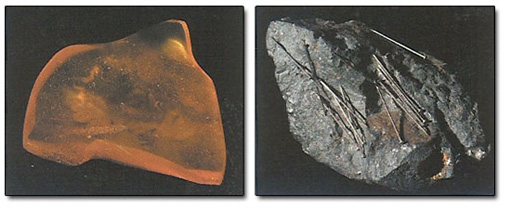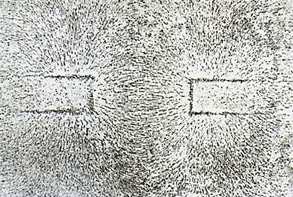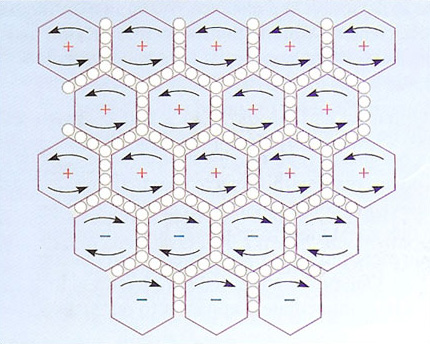2 World-views
2.4 The intangible Universe
2.4.1 Electromagnetism and fields
When Newton wrote about 'The System of the World' in Part 3 of Principia, the only forces he could discuss in any detail were the contact forces that arose when one object touched another, and gravity, which acted at a distance. Even so, Newton thought that there were other forces at work in the world, and hoped they might eventually be brought within his overall scheme just as gravity had been. In fact, Newton wrote:
'I wish we could derive the rest of the phenomena of Nature by the same kind of reasoning from mechanical principles, for I am induced by many reasons to suspect that they may all depend upon certain forces by which the particles of the bodies, by some causes hitherto unknown, are either mutually impelled towards one another, and cohere in regular figures, or are repelled and recede from one another.'
Isaac Newton (1686), Principia.
Amongst the phenomena familiar to Newton, but which he could not treat mathematically, were those of electricity and magnetism, both of which had been known since antiquity (Figure 18). One of the key concepts that Newton lacked, but which eventually proved to be crucial to the quantification of both electricity and magnetism was that of electric charge. This was originally viewed as something like a fluid that could be passed from one object to another, but is now seen, rather like mass, as a fundamental attribute of matter. Just as Newton had been able to make gravity an effective part of the mechanistic world-view by declaring that the gravitational force between two point-like bodies was proportional to the product of their masses and the inverse square of their separation, so the French scientist Charles Coulomb (1736-1806) was able to do the same for electricity by showing that the electrical force between two point-like bodies was proportional to the product of their charges and the inverse square of their separation. In terms of symbols, this can be expressed as:
![]()
However, electrical charge can be positive or negative, and the electrical forces can be attractive or repulsive in accordance with the famous dictum 'like charges repel; unlike charges attract'. Forces between magnets could be treated in a similar way by using north and south magnetic poles in place of positive and negative charges.

The incorporation of electrical and magnetic forces into the mechanistic world-view appeared to be a triumphant vindication of Newton's foresight. But it was really only the beginning of a story, not the end of one. Subsequent investigations were to show that an electric current - a flow of charge - could produce a magnetic force. This showed that the apparently separate subjects of electricity and magnetism were actually different aspects of a single subject: electromagnetism. It was within this unified subject that a new physical concept was to arise, that of a field. The field concept was destined to play an enormously important role in reshaping the physicist's view of the world. It would initially augment the mechanistic world-view, then around 1900, come to rival it, and ultimately, after 1926, play an important part in its downfall.
The field theory of electromagnetism was mainly the creation of two men, Michael Faraday and James Clerk Maxwell. They are, in a sense, the Galileo and the Newton of field theory.
The problem that led Faraday to introduce the concept of a field was an old one: how could one body exert a force on another that was separated from it by empty space? Scientists and philosophers of earlier ages had devised essentially two possible answers:
The simpler but less appealing possibility was that it just happened - that action at a distance was part of the fundamental reality of Nature and, as such, needed no further explanation.
The other possibility was that the notion of empty space was a delusion, that the Universe was actually full of matter, albeit a very subtle and unusual form of matter, and that force was transmitted from one place to another by direct contact between parts of that matter. There were several different proposals concerning the exact nature of this 'subtle matter' that could transmit forces, but it was generally referred to as ether, and theories that made use of it were therefore called ether theories.
Newton's law of gravitation was taken to be an example of action at a distance. The law described the force that one body would exert on another some distance away without any regard to what was in between and without any hint of a mechanism for transmitting the force. Newton was aware that this was a feature of his 'System of the World' that many would find unattractive, but he also realised that he had no evidence on which to base a detailed explanation of gravitational forces. He contented himself with describing gravitational forces mathematically, and said in the Principia, that he would 'form no hypotheses' as to their cause.
Faraday, like others, was willing to accept this situation as far as a purely attractive force like gravity was concerned, or even for a force that could be attractive or repulsive like Coulomb's, but Faraday's own invention of the electric motor showed that the magnetic force on an electric current was not simply attractive or repulsive, it could cause rotation (see Figure 22). Faraday felt that for a wire to rotate around a magnet there had to be something, produced by the magnet but present at the location of the wire, that pushed the wire to one side rather than another. It was this agency, filling the space around the magnet, that Faraday eventually came to call a magnetic field.
Faraday's views about the nature of the magnetic field changed overtime; for complex reasons, he spoke about his field as being different from an ether. Whatever his precise views, Faraday was convinced that fields held the key to understanding magnetic and electrical phenomena. He certainly felt that the curved pattern of lines revealed by sprinkling iron filings onto a sheet of paper placed over a magnet (see Figure 19) showed the presence of a magnetic field. Like a collection of miniature compass needles, the filings showed the field's strength and direction in each region of space. However, he also realised that in order to provide convincing evidence of the reality of the field something more was needed, such as a demonstration that a disturbance at one point in the field would take a finite time to propagate through the field and have visible effects elsewhere. Faraday tried to observe such delays, but failed. Nevertheless, his belief in the physical reality of fields guided his experiments and led him on to new discoveries.

When Maxwell started to work on electromagnetism he studied Faraday's experimental researches and, unlike most of his contemporaries, was impressed by the notion of a field. However, Maxwell had his own reasons for believing in an ether. In particular, he believed that an ether was necessary to account for the propagation of light, which was generally regarded as a kind of wavelike disturbance and was therefore thought to require a medium just as ocean waves require water. Maxwell therefore decided to combine Faraday's field ideas with the ether concept. He set out to treat electricity and magnetism in terms of fields that were themselves interpreted as manifestations of pressure, tension and motion within the ether.

In many ways, Maxwell was extraordinarily successful. He did formulate a mechanical model of the electromagnetic field (Figure 20) and used it as a guide in writing down his now famous equations. Amongst many other things, Maxwell's equations implied that light is a wave phenomenon in which electric and magnetic fields oscillate in space and time. In an astonishing demonstration of the power of these ideas, Maxwell took the fundamental constants of electricity and magnetism, entered them in his equations, and derived an accurate value for the speed of light. In this way, the subjects of electricity, magnetism and optics, which had seemed quite distinct at the beginning of the nineteenth century, were unified into a single branch of physics. The equations even led Maxwell to predict the existence of a wider family of electromagnetic waves, most with wavelengths beyond the range of human sight. In 1888 Heinrich Hertz completed a series of experiments which confirmed the existence of electromagnetic waves with wavelengths much greater than those of visible light. These were the radio waves which, within a few decades, would transform both communication and entertainment. In 1895 Wilhelm Rontgen discovered X-rays, which proved to be electromagnetic waves with wavelengths much smaller than those of visible light. Yet, in spite of these successes, Maxwell's mechanical model of the electromagnetic field remained unconvincing. From about 1865, Maxwell himself drew a clear distinction between his equations, which described the behaviour of electric and magnetic fields, and the underlying ether mechanism that was supposed to account for them. Maxwell firmly believed that he had discovered the correct equations, but did not try to defend the model that had led to them.
If Maxwell had succeeded in accounting for the electromagnetic field in terms of motion in the ether, the mechanical world-view would have reigned supreme; but it was not to be. As investigations continued, particularly after Maxwell's untimely death, it became increasingly clear that it would be impossible to find a convincing mechanical basis for the electromagnetic field. On the other hand, it also became clear that Maxwell's field theory of electromagnetism, as embodied in his equations, was stunningly successful.
Nowadays, with the scaffolding stripped away, we can recognise that the true achievement of Faraday and Maxwell was in establishing the importance of fields, arguably the most radical concept in physics since the time of Newton. We now know that there are many types of field: magnetic fields, electric fields, gravitational fields and so on. Each of these fields has a particular value at each point in space. The key idea is that a particle passing through a given point will experience forces that depend on the fields at that point, or in its immediate vicinity. This means that forces are determined locally - there is no action at a distance. When two particles interact they do so because one particle creates a field in the space around itself and the other particle then responds to this field. What is more, as Faraday anticipated and Maxwell's equations established, the fields have dynamics of their own, allowing disturbances of electric and magnetic fields to spread out as waves. Crucially, this means that fields should be thought of as part of the fabric of the world - more intangible than matter, but just as real. The electromagnetic field on Earth is incredibly complex. While you are reading this, electromagnetic waves from all the channels that your radio and television could possibly receive are passing straight through your head. Added to this are signals from power lines, domestic appliances, cars and the Big Bang; tiny electromagnetic signals are even reaching you from the brains of those around you. One of the attractions of physics is its ability to reveal a much richer world than is immediately apparent to our senses. And much stranger things are yet to come.
Question 4
Describe one way in which Maxwell's theory satisfied Faraday's desire to find evidence that disturbances at one point in the electromagnetic field would take a finite time to reach other points.
Answer
Electromagnetic waves are predicted by Maxwell's equations, as disturbances of Faraday's electric and magnetic fields. The disturbances travel at the speed of light, which is finite. Thus Faraday's idea that disturbances of fields should travel at a finite speed was confirmed.
